Solar nebula - Study guides, Class notes & Summaries
Looking for the best study guides, study notes and summaries about Solar nebula? On this page you'll find 216 study documents about Solar nebula.
All 216 results
Sort by
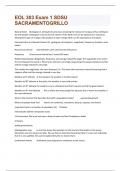 Popular
Popular
-
EOL 303 Exam 1 SDSU SACRAMENTOGRILLO QUESTIONS WITH ALL CORRECT SOLUTIONS!!
- Exam (elaborations) • 5 pages • 2024
- Available in package deal
-
- $7.99
- 1x sold
- + learn more
Natural Event Geological or atmospheric processes involving the release of energy and has nothing to do with people. Geological is due to the hot interior of the Earth and can be expressed as volcanoes. Atmospheric type of energy is the product of solar energy which can be expressed as tornadoes. Characteristics of a Natural Disaster (5) geological, atmospheric, magnitude, frequency, duration, areal extent Recurrence interval time between same sized events (150 years) frequency 1/recurrenc...
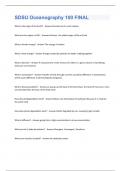 Popular
Popular
-
SDSU Oceanography 100 FINAL Questions With Correct Solutions, Already Passed!!
- Exam (elaborations) • 11 pages • 2024 Popular
- Available in package deal
-
- $7.99
- 1x sold
- + learn more
What is the origin of the Earth? - Answer-Formed out of a solar nebula What are the origins of Life? - Answer-Archaea - the oldest origin of life on Earth What is kinetic energy? - Answer-The energy of motion What is heat energy? - Answer-Energy created by particles of matter rubbing together What is density? - Answer-A measurement of the amount of matter in a given volume of something. (mass per unit volume) What is convection? - Answer-Transfer of heat through currents caused by differen...

-
ASTR 205 Final Exam
- Exam (elaborations) • 7 pages • 2023
- Available in package deal
-
- $10.00
- 4x sold
- + learn more
What makes up 99.8% of the solar system's mass? The sun Mercury, Venus, Earth and Mars are called what type of planets? Terrestrial Terrestrial planets are ________ in size and ______ in mass and have a _______ density of 3.9-5.5 g/cm3 Small; Low; High What terrestrial planet is the densest of them all. Earth Jupiter, Saturn, Uranus and Neptune are called what types of planets? Jovian Jovian planets are ______ is size, ______ in mass and have a _______ density of about 0.7-1.6 g/c...
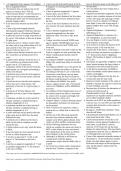
-
ASTR 114 Astronomy - Final Exam "Cheat Sheet" | Latest 2023-2024
- Exam (elaborations) • 6 pages • 2023
-
- $7.99
- 2x sold
- + learn more
-1.5 magnitude Sirius appears 25x brighter than 2 magnitude Polaris. “All neutron stars are pulsars, but not all pulsars are neutron stars” FALSE “Spectroscopic Binary” is the term given to a pair of stars that we can determine are orbiting each other only by measuring their periodic Doppler shifts. A 6.8 solar mass neutron star does NOT exist. A loop of gas and charged particles following the magnetic field lines between sunspot’s poles is a Prominence/...
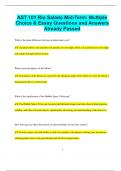
-
AST 101 Rio Salado Mid-Term: Multiple Choice & Essay Questions and Answers Already Passed
- Exam (elaborations) • 62 pages • 2024
-
- $11.99
- + learn more
AST 101 Rio Salado Mid-Term: Multiple Choice & Essay Questions and Answers Already Passed What is the main difference between a planet and a star? A planet orbits a star and does not produce its own light, while a star generates its own light and energy through nuclear fusion. What causes the phases of the Moon? The phases of the Moon are caused by the changing angles from which we view the Moon’s illuminated half as it orbits Earth. What is the significance of the Hubble Sp...

-
SDSU Ocean 100 Final SacramentoGrilo Latest Version Already Passed
- Exam (elaborations) • 39 pages • 2024
- Available in package deal
-
- $10.99
- + learn more
SDSU Ocean 100 Final SacramentoGrilo Latest Version Already Passed origin of earth • Supernova: death of a star (great explosion) • Supernova happened 4.6 bya, dust and gas flattens to a disk and spins faster due to gravity and solar nebula formed. • Solar Nebula: describes formation of Earth 4.5 bya • Nebula: gas cloud origin of oceans • volcanic explosion, H2O condensed and rained down for thousands of years to create oceans • icy comets hitting earth (respon...
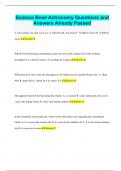
-
Science Bowl Astronomy Questions and Answers Already Passed
- Exam (elaborations) • 26 pages • 2024
- Available in package deal
-
- $9.99
- + learn more
Science Bowl Astronomy Questions and Answers Already Passed A solar eclipse can only occur at a: A. full moon B. new moon C. 1⁄2 gibbous moon D. 1⁄4 gibbous moon Answer: B Which of the following constellations cannot be seen in the summer sky of the northern hemisphere? A. Libra B. Orion C. Ursa Major D. Cygnus Answer: B What percent of stars in the sky that appear to be single stars are actually binary stars: A. about 90% B. about 50% C. about 20 % D. about .5% Answer: B T...
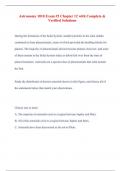
-
Astronomy 1010 Exam #2 Chapter 12 with Complete & Verified Solutions
- Exam (elaborations) • 12 pages • 2024
-
- $8.99
- + learn more
Astronomy 1010 Exam #2 Chapter 12 with Complete & Verified Solutions During the formation of the Solar System, smaller particles in the solar nebula combined to form planetesimals, some of which provided the building blocks for planets. The majority of planetesimals did not become planets, however, and some of them remain in the Solar System today as debris left over from the time of planet formation. Asteroids are a special class of planetesimals that orbit around the Sun.
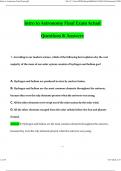
-
Intro to Astronomy Final Exam (2024 / 2025) Actual Questions and Verified Answers, 100% Guarantee Pass
- Exam (elaborations) • 39 pages • 2024
-
- $14.99
- + learn more
Intro to Astronomy Final Exam (2024 / 2025) Actual Questions and Verified Answers, 100% Guarantee Pass According to our modern science, which of the following best explains why the vast majority of the mass of our solar system consists of hydrogen and helium gas? A. Hydrogen and helium are produced in stars by nuclear fusion. B. Hydrogen and helium are the most common elements throughout the universe, because they were the only elements present when the universe was young. C. All the other ...
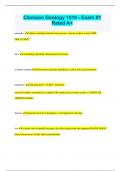
-
Clemson Geology 1010 - Exam #1 Rated A+
- Exam (elaborations) • 27 pages • 2024
- Available in package deal
-
- $9.99
- + learn more
Clemson Geology 1010 - Exam #1 Rated A+ principles claims something that has been proven - known to all as correct (BIG DISCOVERY) facts something repeatedly demonstrated to be true scientific method observation, question, hypothesis, collect data, and evaluation hypothesis educated guess; "if-then" statement; must be testable; be predictive; complex OR simple; past or future events; CANNOT BE OPINION BASED theories repeated proof for a hypothesis; well supported with data law a theory th...

That summary you just bought made someone very happy. Also get paid weekly? Sell your study resources on Stuvia! Discover all about earning on Stuvia


